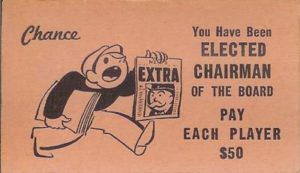
“Fundraising is the board’s main job.” I was stunned by this blunt advice from the executive director of a respected arts nonprofit. “I tell every new board member,” she continued, “‘Give, get—or get out.’ We expect each member to produce at least $5,000, either out of their own pockets or by asking others.”
It was certainly a different notion of Board membership than I had learned from my experience in churches! The church boards I’d worked with delegated fundraising responsibility to the stewardship committee, and had as little to do with it as possible. Something in this arts administrator’s frank talk had appeal.
In the years since then, I’ve worked with many congregations’ boards. While I rarely enter as a fundraising consultant, worry about money is never far from board members’ minds. How can boards—and board members—help the congregation to raise the funds necessary to support its work?
Most boards try to avoid this challenge, but a few embrace it and say, “Stewardship is a lay responsibility. As the lay board, we’ll run the fund drive.” As noble as such boards’ intentions are, the notion that a board can take on fundraising (or any other practical task) is fundamentally wrongheaded. Boards don’t do work, people do. A board can talk about fundraising, but nothing happens till some board member takes responsibility for doing it—and the doing happens almost entirely away from the board table. Nothing wrong with that. But it is not “the board running the fund drive.”
The board’s real contribution starts with stating the goals the fund drive will achieve. The first task for too many stewardship committees is to choose a theme or vision for the fund drive. What’s needed, though, is not a vision for the fund drive, but a vision for the congregation. Only the board—acting in concert with the clergy leader and with the support of the whole leadership—has the authority to pronounce the congregation’s vision.
A second necessary contribution from the board is to identify the “ask.” How much is the congregation asking each of its members to give? This is a complicated matter, because no one number (or even any one percentage) will be right for everyone. But every congregation gives some message on this subject, intentionally or inadvertently. And here is a bit of truth in the advice from my friend the arts administrator: one of the strongest signals any organization sends is its board members’ own giving. Even when giving levels are supposedly a secret, the signal goes out and influences everybody else’s giving.
It follows that one of the most important conversations any board can have is about its expectations of its members with respect to their financial giving.
A third essential contribution boards can make to the success of the fund drive is to ensure that it has competent, accountable leadership. When I pressed the executive director about how the board actually participated in raising money, she admitted that she was responsible for the fund drive itself, working through a volunteer she had selected. (A big nonprofit would employ a paid development director.) Board members served as volunteers within that staff-led structure.
This is as it should be. Fund raising is part of the congregation’s ministry, whether it takes the form of a bake sale or a stewardship pledge drive. The best way to organize for practical activity is to put someone competent in charge and let them do the job. The best way to ensure the unity and harmony of all the congregation’s work is to create a single structure to hold all of it.
Not all clergy welcome the responsibility for running a fund drive, and fewer still will want to be involved hands on. But you can be responsible for things without doing them, and as a practical matter, clergy are accountable for the success of fundraising—in the sense of receiving the consequences of success or failure—whether they like it or not. Who, better, then, to choose and support the competent leadership fundraising requires?
The board’s contribution to fundraising success is essential, but it does not include “running the fund drive.” It does include expecting board members to contribute gifts and volunteer work, and articulating the vision that successful fundraising supports. The board’s makes its unique and indispensable gift to the fund drive when it leads in ways only the board can do.
Dan Hotchkiss has consulted with a wide spectrum of churches, synagogues, and other organizations spanning 33 denominational families. Through his coaching, teaching, and writing, Dan has touched the lives of an even wider range of leaders. His focus is to help organizations engage their constituents in discerning what their mission calls for at a given time, and to empower leaders to act boldly and creatively.
Dan coaches leaders and consults selectively with congregations and other mission-driven groups, mostly by phone and videoconference, from his home near Boston. Prior to consulting independently, Dan served as a Unitarian Universalist parish minister, denominational executive, and senior consultant for the Alban Institute.


